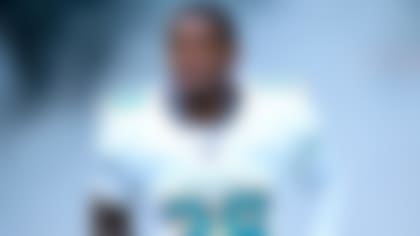The NFL has long followed a player-acquisition system designed to give weaker teams the best possible chance to get better in a hurry and, therefore, help promote competitive balance. And this year, the rules could very well tilt the playing field more heavily in their favor.
Sharper on the move?
Darren Sharper wants to come back and play for New Orleans, but he told NFL.com's Steve Wyche that he's confused by the fact that the Saints are willing to let him test the free-agency market. **More ...**
If, as expected, no new CBA is reached between the NFL and the NFL Players Association by March 5, one of several changes impacting acquisitions will be severe limitations on the ability of the eight teams that reached the divisional playoffs to sign free agents.
That figures to make April's draft particularly important for those teams. Even if some, such as the Indianapolis Colts, don't face serious roster makeovers, they all have at least some key starting or backup holes to fill. And their challenge is already tougher by the fact that they're choosing near the bottom.
Entering this week's NFL Scouting Combine, I'm taking a closer look at how the divisional-round teams could be impacted by the possible implementation of the Final Eight rules. In general, they would limit all eight teams to signing one unrestricted free agent (a player with six or more years of NFL service) for each one of their own lost, and can only sign a new UFA to a salary similar to what the departing player gets, with limits on annual increases. The four teams that lost in the divisional round can sign additional unrestricted free agents, but with restrictive financial parameters imposed.
Here's my breakdown of the situation:
New Orleans: The Saints' primary focus is on retaining their own unrestricted free agents, which shouldn't be too difficult considering they have only two starters likely headed for the open market: standout safety Darren Sharper and linebacker Scott Fujita. The Saints' pre-draft evaluation is likely to target defensive help. They need to get younger at linebacker, and that seems particularly true with strongside linebacker Scott Shanle. They also will have an eye out for depth at defensive tackle. There is speculation the Saints could add draft choices by trading one or more of their restricted free agents. They could be looking to deal one of three offensive tackles who fall into that category -- Jammal Brown, Jermon Bushrod or Zach Strief -- because of their exceptional experience at the position.
Indianapolis: The Colts return most of the starters from their Super Bowl team, and their sole free-agency focus is on retaining UFA linebacker Gary Brackett. Considering team president Bill Polian publicly called out the play of the offensive line as a shortcoming in the Super Bowl XLIV loss to the Saints, it's logical to assume that the Colts will take a closer look at that position during the combine and throughout their pre-draft intelligence gathering. One possibility for their 31st overall pick is Idaho guard Mike Iupati, whose tough and aggressive style could very well provide some immediate improvement. Defensive tackle and outside linebacker are other spots that should command extra attention.
Minnesota: The only meaningful question mark that looms over the Vikings' roster is whether Brett Favre will return for a second season as their quarterback. Given his history, Favre is likely to keep the team twisting in the wind for most, if not all, of the offseason before deciding (and we use the term loosely) whether to continue playing. Vikings vice president of player personnel Rick Spielman told reporters in Minnesota that this is "going to be a really strong draft," because of a heavy infusion of "talented juniors." That is very good news for the Vikings and the rest of the teams with late picks. At No. 30, the Vikes should be able to find some solid help at safety, which proved to be the weakest area of an otherwise superior defense. Secondary is considered one of the deepest areas of the draft, and one safety prospect whom the Vikings could land in the first round is Taylor Mays of USC. Defensive tackle is another spot they will be monitoring closely, and it also would make sense to think about picking up a quarterback somewhere along the line.
N.Y. Jets: After last year's big free-agent splash, the Jets are expected to tone things down considerably this offseason. They will rely heavily on the draft to help them close the gap that left them one step short of the Super Bowl. An obvious area of need is at defensive end, where the Jets were plagued by players who were too old to keep up with the pace of an extended season. Although they have the league's best cornerback in Darrelle Revis, that is another position they're expected to address because of the exceptional depth it offers this year.
Not out of charge
NFL.com's Steve Wyche writes that LaDainian Tomlinson has value for a Super Bowl contender, even if he's no longer the featured back. So which teams could use L.T.? **More ...**
San Diego: The Chargers' priority couldn't be any clearer: They need a running back. The release of LaDainian Tomlinson is one move that makes that obvious. Another will be if they allow Darren Sproles to become a free agent since they aren't expected to hit him with another franchise tag. Although the Chargers clearly would be in the market to acquire a running back via trade or free agency, they no doubt will be focused on finding one in the draft. It's difficult to say whether they'll be able to find a quality player at the position with the 28th overall choice, but there's always a chance that a good one (such as Jonathan Dwyer of Georgia Tech) could slide to that spot.
Dallas: The Cowboys are in pretty good shape to make another strong playoff run. Their biggest weakness is at offensive tackle, where aging Flozell Adams has become a liability. The 27th overall pick gives them a chance to address the position in a meaningful way if highly talented Bruce Campbell of Maryland is there. With this being such a strong draft for defensive backs, the Cowboys can be expected to go in that direction with one of their early picks as well.
Arizona: It might not be quite the hole the Chargers have, but the Cardinals seemingly need to do something with their quarterback position in the wake of Kurt Warner's retirement. Coach Ken Whisenhunt can't possibly be married to Matt Leinart, whom he inherited and has no reason to believe can carry the load as a starter (or he would have gotten the job ahead of Warner). The question is, can the Cards find a starting QB in a draft that looks very thin at the position? Notre Dame's Jimmy Clausen is one possibility with their 26th overall choice, although some NFL talent-evaluators think that could very well be too high of a pick for him.
Baltimore: The Ravens are desperate for help at wide receiver. They took at least a moderate risk in picking up Donte' Stallworth as a free agent. Now, they are looking toward the draft to find additional help at the position. They could always go with a pass-catching tight end with their 25th overall pick. Cornerback and defensive end also make sense to be addressed in the early rounds.
A few thoughts on L.T.
It was sad, but inevitable, that the San Diego Chargers parted ways with Tomlinson.
He no longer had what it took, physically, to be their featured running back. I suspect, even though he apparently aspires to continue playing, that other teams are going to have the same view.
Tomlinson made his career on being a constant hit-the-hole-and-be-gone threat. He doesn't have that ability anymore. To continue to have any sort of value, he would need to adjust his game and become more of a player who does more plugging and scratching than exploding. That just doesn't seem like something Tomlinson would ever become.
He also apparently would like to join a contender, which makes perfect sense at this stage of his career. But most teams in that position are pretty well set at running back or, like the Chargers, have premier quarterbacks and, therefore, would have no desire to make their ground game the focal point of their offense.
Tomlinson has stretched as much as any running back could out of a nine-year career. His body of work should make him a first-ballot selection to the Pro Football Hall of Fame. Tomlinson might be concerned that he needs to win a Super Bowl in order to seal the deal, and, therefore, wish to hook on with a contender. But that isn't necessary.
He turns 31 in June, and that simply is not a good place to be for an NFL running back. Tomlinson could retire now, having made a tremendous mark on the league and on the Chargers, for whom he has been as great a franchise face as any player could be for any team.
Rams' dilemma
It's hard to imagine the St. Louis Rams not using the top overall pick of the draft on a defensive tackle.
The most talented player in the draft plays that position, whether his name is Ndamukong Suh of Nebraska or Gerald McCoy of Oklahoma. The team's philosophy of building from the inside out is sound, especially with how far the Rams need to go just to become respectable.
But this is also a franchise that has taken the extreme measure of cutting its ticket prices in order to make itself more attractive to fans who are becoming less and less interested in going to its games. A defensive tackle simply isn't a sexy enough pick to help fill seats. A quarterback is, and the Rams clearly have a need there as well.
The problem with this draft is that it doesn't have a quarterback who is an obvious top-overall pick. The lone possibility is Sam Bradford of Oklahoma, but he has a long way to go in the next couple of months to prove his viability as someone who merits being picked in the top 10, let alone at No. 1. Bradford's spindly frame is one concern. So is his recovery from the shoulder injury he suffered last season.
[
[ For more on the
New York Giants, check out the latest from our bloggers.
Marathoners aren't football players
A word of caution for the New York Giants, who are planning to implement techniques from marathon runners and triathletes into their offseason conditioning program: Marathoners and triathletes aren't football players.
I get the part about looking for a way to help improve the team's overall stamina. However, it's hard to envision athletes used to power-oriented and quickness training suddenly becoming comfortable with the tactics utilized by individuals focused solely on endurance. Football is mostly played within a confined area, and players think accordingly in their preparation.
Maybe that's why this is something that has never been done with a football team. Maybe that's also why the Giants are going to start with a test group of 15 players and see where it goes.



